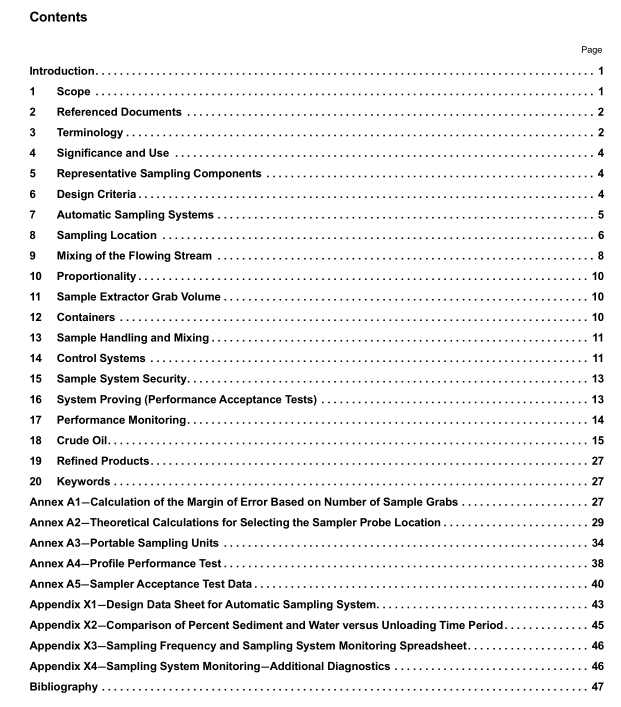API MPMS 8.2 pdf download

API MPMS 8.2 pdf download Manual of Petroleum Measurement Standards Chapter 8.2 Standard Practice for Automatic Sampling of Petroleum and Petroleum Products
9.4.2 Multiple Run Metering Systems and Headers—When a sampling system is used in conjunction with a multiple-run metering system, the sample point should not be located on an individual meter run, inlet, or outlet header. For example, a horizontal pipeline carrying crude oil and water will, at low flow rate, have the potential for stratification resulting in free water, which is likely to be divided unevenly between the metering streams. Additionally, flow patterns within headers are unpredictable and impacted by the number and order of streams in service. The sampling system may be located upstream or downstream ofthe metering system. Ifthe velocity of the product in the pipe at the sample point does not provide adequate homogeneity for sampling (under worst-case flow and product conditions), the system requires additional stream conditioning. (For water-in-oil sampling, see C1/C2 calcula- tions in Annex A2 for further guidance around mixing.)
9.4.3 Stream Blending—Ensure automatic sampling systems are sufficiently downstream of points where different streams are blended to enable thorough mixing to occur.
10. Proportionality
10.1 An automatic sampling system controller paces a sampling device to extract representative samples throughout a batch or period. The proportionality of the samples being extracted can be defined by the following categories:
10.1.1 Flow-Proportional Sampling:
10.1.1.1 Custody Transfer Meters—Use custody transfer meters to pace the sampler where available. When using a single sampling point and measuring flow by multiple meters, pace the sampler by the combined total flow signal. In some circumstances, install a separate sampling system in each meter run. In this case, pace the sampler by the meter it is supporting (API MPMS Chapter 5).
10.1.1.2 Special Flow Rate Indicators—Automatic tank- gauging system for custody transfer may pace the sampling system in proportion to flow API MPMS Chapter 3.
10.1.1.3 An add-on flow metering device such as a clamp-on meter may be able to pace the sampling in proportion to flow.
10.1.2 Time-Proportional Sampling—Sampling in a time- proportional mode is acceptable ifthe flow rate variation is less than 610 % of the average rate over the entire batch and if the sampling stops when the flow stops.
10.2 Care shall be taken not to sample faster than either the sample extractor or the sample control system is capable of operating. Operating a sampling system in this manner will result in a non-representative sample.
11. Sample Extractor Grab Volume
11.1 Sample extractors extract a wide variety of volumes per sample grab. When designing the sample system, consider the extractor grab volume and the container volume. The extraction of larger volumes per grab may require a larger container to accommodate the number of grabs per batch. For non-homogeneous (for example, crude) applications, see An- nex A1 to calculate the margin of error depending on the number of grabs.
11.2 Larger grab volumes may also be required to fill a container to an acceptable level per Practice D5854 (API MPMS Chapter 8.3) during small-volume batches delivered at high flow rates. For the same overall volume collected, larger sample grab volumes will reduce the sample frequency and also the resolution of the sample.
11.3 Sample grab volumes should be repeatable within 65.0 %. The nominal grab volume (as determined by the sample probe manufacturer) is not necessarily the same as the actual grab volume. For purposes of establishing the sampling frequency for a batch, only the actual volume should be used.
11.4 The actual grab volume may be determined as an average by measuring 100 grabs into a suitably sized graduated cylinder. The volume contained in the cylinder at the end oftest shall be divided by 100 (or the number of grabs taken) to establish the actual grab volume.
11.4.1 For example, ifa sampler grabs 100 samples with the nominal grab size of 1.0 mL and an actual grab size of 1.2 mL, the end result would be 120 mL. In that situation, the person taking the sample could expect to observe anywhere from a low of 114 mL to a high of 126 mL during future verifications of the grab size.









